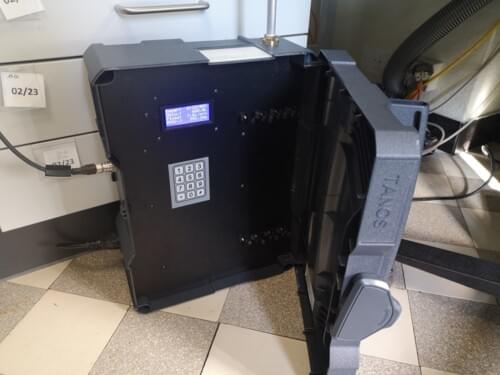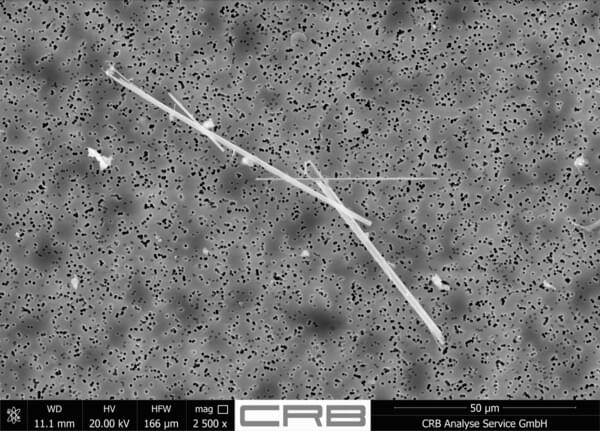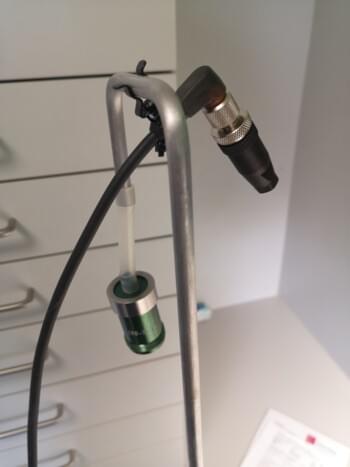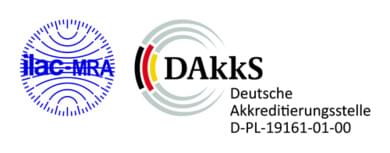Indoor air measurement: test air for asbestos
To ensure the safety of our employees, we regularly take indoor air samples in our test laboratory and then test them for asbestos fibers, KMF, or carbon fibers. In this article, we report who is subject to mandatory indoor air analyses and what to look for to prevent measurement errors.
"It doesn't release asbestos after all."
Everyone who works with the pollutant asbestos knows the safety requirements. That's where habit quickly creeps in. That no asbestos will be released if work is done carefully and properly is true in most cases. But mistakes cannot be ruled out. Only a room air measurement brings certainty to the questions:
- Is asbestos in the room air?
- How high is the fiber concentration in the room air?
- How high is the risk according to the exposure-risk matrix as per TRGS 519?
- Remediation control (after successful remediation): Does post-cleaning have to be done again?
 For whom are indoor air analyses mandatory?
For whom are indoor air analyses mandatory?
Anyone who works with materials containing asbestos - whether in the renovation of buildings or the analysis of samples - cannot avoid regular determination of the fiber concentration in the indoor air: Indoor air analyses are required by law and the rules for them are strict. This is for workplace safety because asbestos remains extremely carcinogenic and dangerous.
When is a room air test for asbestos useful?
Indoor air measurements are primarily used to control remediation measures that have been carried out and to establish and verify low-exposure procedures. They can also be used to test and classify the exposure of workers when working with asbestos. The measured exposures are used to derive the protective measures to be taken in each case.
This is also the reason why we check the indoor air for asbestos in our laboratory at regular intervals. This is mainly to check our protective measures.
When is a room air analysis for asbestos not useful?
As a rule, a room air measurement is not useful when it comes to searching for potentially asbestos-containing materials. It is also not useful when there are unexplained health complaints. Since the latency period of most asbestos-related diseases is comparatively long, measuring current air exposure is pointless in this case. If the complaints occur suddenly, a doctor should always be consulted. Particularly in the case of complaints that occur at short notice and possibly only for a short time, one should also always keep an eye on other pollutants such as mold.
A room air measurement is also not useful if there is a diffuse suspicion of the presence of materials containing asbestos. Here it is always more sensible to search for the materials oneself, if necessary with the help of a building pollutants expert.
Even potential releases of asbestos that occurred very long ago cannot be detected with the help of an air measurement.
How can asbestos be measured in the air?
The details of measuring and calculating the concentration of asbestos fibers in indoor air are regulated in DGUV Information 505-46 and VDI 3492.
Sampling is quite simple: a pump draws a determinable volume of air through a filter (membrane) with a defined area.
Fibers contained in the air get caught in the membrane and can later be analyzed and counted in a scanning electron microscope. This allows the fiber concentration in the air breathed to be calculated in fibers per cubic meter of air. CRB performs these asbestos tests of indoor air in its own laboratory.

SEM image: asbestos fibers on a filter
How long does a room air measurement take?
Setting up the measuring equipment is quick. The measurement itself usually takes up to 8 hours.
How is the asbestos concentration in the air calculated?
The fiber concentration per m3 of room air is calculated as follows:
Fibers/m3 =
|
(Note: The counting field is composed of a corresponding number of image fields to be requested. The area of the counting field corresponds to the area of the total scanned filter area. This varies with the number of image fields searched. Ultimately, this area determines the detection limit of the method for a given volume throughput.)
Example calculation:
Counted fibers: 10
Aspirated air volume: 3.840 liters (= 3,84 m3)
Area of one counting field: 0,0261 mm2
Number of evaluated counting fields: 36 (corresponds to 1,03 mm2)
Effective area of the membrane: 380 mm2
CF = 10 • 380 mm2 / 36 • 1,03 mm2 • 3,84 m3 = 961 fibers/m3 room air
This value clearly exceeds the permissible limit value according to TRGS 519 of 500 fibers/m3 room air! The consequence: We are no longer dealing with a low-risk activity (at least inside buildings) and must take correspondingly higher protective measures. In the case of remediation control, a new final cleaning is necessary.

Measurement uncertainty for room air analysis
The distribution of fibers in the room air and thus also on the filter surface is random. Therefore, the measured fiber count deviates from the true value. The deviations occur in all individual steps of the procedure, such as sampling, preparation, and evaluation of the filter. The random scatter of the measurement result is estimated using Poisson statistics.
1. Sampling
In large rooms, the fiber concentration can be more diluted by expansion than in smaller rooms. This plays a role, especially in a utilization simulation where existing dust deposits are blown on. On the other hand, in very small rooms there may be a decrease in fiber concentration caused by the sampling device itself (dust suction effect).
The usage simulation generates a high fiber concentration at the beginning of the measurement, which slowly decreases in a curve due to sedimentation or air exchange. To ensure comparability of different measurements, the measurement duration should not exceed 8 hours.
2. Evaluation
Here, the detection and identification of very thin fibers as well as the experience of the analyst can play a major role.
A good measurement setting is therefore crucial for correct measurement results. This may mean a little more time and thus, of course, somewhat higher costs for the air analysis. However, good indoor air measurements and asbestos tests are usually much less expensive than any cleaning measures that may be ordered or even the shutdown of the entire work area.
We help you to find professionals for indoor air measurement
We do not carry out indoor air measurements ourselves, but only asbestos analysis of indoor air samples. However, we know measurement professionals all over Germany (Europe? Worldwide?) and will gladly assist you in finding a provider near you.
Simply ask us by message via our contact form, by e-mail to labor@crb-gmbh.de, or by phone at +49 (0) 5505 940 980 and we will recommend a service provider for indoor air measurements in your region.
CRB reliably tests your indoor air samples for asbestos
The samples have already been taken and you are looking for a competent partner for asbestos analysis? Feel free to contact us. As an accredited laboratory, we perform asbestos tests for charged air filters and provide you with fast, reliable, and court-proof results.


